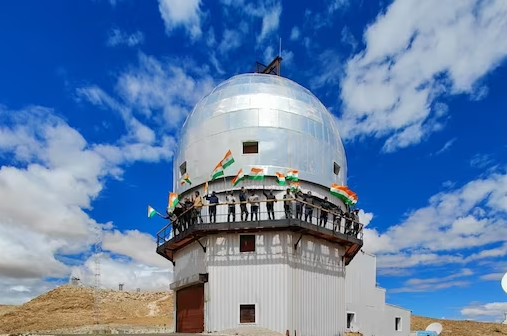- Courses
- GS Full Course 1 Year
- GS Full Course 2 Year
- GS Full Course 3 Year
- GS Full Course Till Selection
- Online Program
- GS Recorded Course
- NCERT (Recorded 500+ Hours)
- Polity Recorded Course
- Geography Recorded Course
- Economy Recorded Course
- AMAC Recorded Course
- Modern India, Post Independence & World History
- Environment Recoded Course
- Governance Recoded Course
- Science & Tech. Recoded Course
- International Relations and Internal Security Recorded Course
- Disaster Management Module Course
- Ethics Recoded Course
- Essay Recoded Course
- Current Affairs Recoded Course
- CSAT
- 5 LAYERED ARJUNA Mentorship
- Public Administration Optional
- ABOUT US
- OUR TOPPERS
- TEST SERIES
- FREE STUDY MATERIAL
- VIDEOS
- CONTACT US
Night Sky Sanctuary in Ladakh
Night Sky Sanctuary in Ladakh
29-11-2023

Why in News?
Recently, The Indian government has announced the upcoming establishment of South East Asia's first Night Sky Sanctuary in Ladakh.
What are the Key Points Related to Night Sky Sanctuary in Ladakh?
- The project will be situated in Hanle village, Eastern Ladakh, as part of the Changthang Wildlife Sanctuary.
- The Indian Institute of Astrophysics Bengaluru, affiliated with the Department of Science & Technology, Govt. of India, is providing support for its establishment.
- The Indian Astronomical Observatory, located over 1,073 square kilometers, is the world's second-highest optical telescope.
- India's astro-tourism will increase due to its status as a top site for optical, infra-red, and gamma-ray telescopes globally.
What are the Major Types of Dark Sky Places?
- The International Dark Sky Association, a U.S.-based non-profit, categorizes places as International Dark Sky Places, Parks, Sanctuaries, and Reserves based on their meeting criteria.
- Dark Sky Parks: Conservation areas, whether public or private, are areas that utilize effective outdoor lighting practices and offer programs focusing on observing dark skies.
- Dark Sky Sanctuaries: These remote and often dark regions on Earth necessitate strict conservation measures due to their fragile state.
- Dark Sky Reserves: Reserves have a designated dark "core" zone surrounded by populated areas, with policies implemented to protect this zone while accommodating nearby communities.
- Urban Night Sky Places: Urban sites aim to offer an authentic nighttime experience despite artificial light, focusing on creating environments that allow people to appreciate the night sky.
- Dark Sky Communities: Cities and towns are recognized for their high-quality outdoor lighting ordinances and efforts to educate residents about the importance of preserving dark skies.




